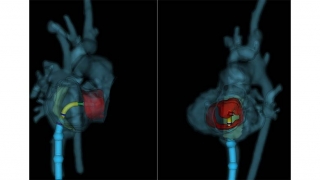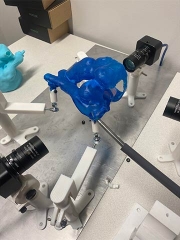 Virtual, patient-specific model created for planning TEER procedure Researchers and clinicians at Children's Hospital of Philadelphia (CHOP) have successfully tested a novel approach to help avoid performing open heart surgery on patients with severe complications related to congenital heart disease. The findings from four patients were recently published online by the journal Catheterization and Cardiovascular Interventions.
Virtual, patient-specific model created for planning TEER procedure Researchers and clinicians at Children's Hospital of Philadelphia (CHOP) have successfully tested a novel approach to help avoid performing open heart surgery on patients with severe complications related to congenital heart disease. The findings from four patients were recently published online by the journal Catheterization and Cardiovascular Interventions.
Atrioventricular valve regurgitation (AVVR) is the most common form of valve disease associated with congenital heart disease and is a devastating complication that results in increased mortality risk in children and young adults affected by the condition. Transcatheter edge-to-edge repair (TEER) is a minimally invasive procedure that has been used to treat adults with certain cardiovascular issues with great success. However, it has not been extensively explored for use in patients with congenital heart disease or children.
In this case study, the TEER procedure was performed in four patients under the age of 21 using the MitraClip delivery system. MitraClip is a small device delivered via a catheter that is approved by the U.S. Food and Drug Administration to stop leaking in the mitral valve, which controls blood flow between the lower left and the upper left chambers of the heart. MitraClip has been used in other TEER procedures in adults.
The CHOP team developed a standardized screening and planning process for patients using cardiac magnetic resonance imaging, three-dimensional echocardiography and virtual and physical simulation, including the 3D Slicer program that allows researchers to view chambers of the heart in three dimensions. This allowed the team to conduct "procedure rehearsals" before treating the patients. All four patients had severe AVVR. Three patients required a Fontan operation while one required a repair of a common atrioventricular canal defect. In all four cases, following the protocol allowed each patient to undergo the TEER procedure, and in each case, the MitraClip was successfully placed in the intended location, thereby avoiding open heart surgery.
 Plastic model of patient-specific anatomy created for planning TEER procedure "While TEER has not typically been used in pediatric populations, the results of this study have potential to open the doors for its application to other childhood heart complications," said Matthew J. Gillespie, MD, an attending cardiologist in the Cardiac Center, Medical Director of the Cardiac Catheterization Laboratory at CHOP and senior author of the study. "Further, the infrastructure that we've created here at CHOP will allow us to pursue other new therapeutic avenues for our patients moving forward."
Plastic model of patient-specific anatomy created for planning TEER procedure "While TEER has not typically been used in pediatric populations, the results of this study have potential to open the doors for its application to other childhood heart complications," said Matthew J. Gillespie, MD, an attending cardiologist in the Cardiac Center, Medical Director of the Cardiac Catheterization Laboratory at CHOP and senior author of the study. "Further, the infrastructure that we've created here at CHOP will allow us to pursue other new therapeutic avenues for our patients moving forward."
CHOP is currently the only freestanding children's hospital offering TEER, and while it is not typically offered in a pediatric hospital setting, further investigation of the procedure will be needed to determine long term outcomes and how to maximize the potential benefit of utilizing TEER in children before they experience symptomatic heart failure.






